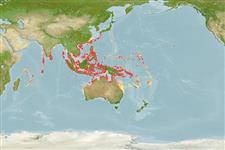Classification / Names
Common names from other countries
Main reference
Size / Weight / Age
Max length : 12.0 cm TL male/unsexed; (Ref. 9710)
Environment
Marine; reef-associated; depth range 3 - 20 m (Ref. 1602)
Climate / Range
Tropical, preferred ?; 31°N - 30°S, 52°E - 179°W
Distribution
Indo-West Pacific: East Indies and the Philippines, through Papua New Guinea and the Great Barrier Reef to the Solomon Island, Palau, and north to China; extends into the Indian Ocean at least to the Maldives, India and Sri Lanka.
Countries | FAO areas | Ecosystems | Occurrences | Introductions
Short description
Dorsal
spines
(total): 10 - 12;
Dorsal
soft rays
(total): 17-19;
Anal
spines: 3-4;
Anal
soft rays: 14 - 17. White to yellowish below with 7 black stripes over head and sides, one centrally on snout and another as a strong black margin on end of dorsal and anal fins. Third line extends onto ventral fin (Ref. 48636). Snout length 3.0-4.1 in HL. Body depth 1.4-1.6 in SL (Ref. 90102).
IUCN Red List Status (Ref. 115185)
Threat to humans
Harmless
Human uses
Aquarium: commercial
More information
ReferencesAquacultureAquaculture profileStrainsGeneticsAllele frequenciesHeritabilityDiseasesProcessingMass conversion
Tools
Special reports
Download XML
Internet sources
Estimates of some properties based on models
Phylogenetic diversity index
PD50 = 0.5000 many relatives (e.g. carps) 0.5 - 2.0 few relatives (e.g. lungfishes)
Trophic Level
2.6 ±0.40 se; Based on food items.
Resilience
High, minimum population doubling time less than 15 months (Preliminary K or Fecundity.)
Vulnerability
Low vulnerability (10 of 100)
Price category
